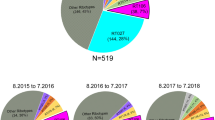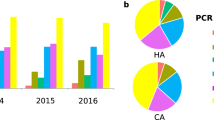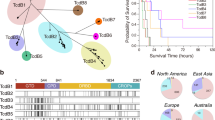Abstract
Epidemic C. difficile (027/BI/NAP1) has rapidly emerged in the past decade as the leading cause of antibiotic-associated diarrhea worldwide. However, the key events in evolutionary history leading to its emergence and the subsequent patterns of global spread remain unknown. Here, we define the global population structure of C. difficile 027/BI/NAP1 using whole-genome sequencing and phylogenetic analysis. We show that two distinct epidemic lineages, FQR1 and FQR2, not one as previously thought, emerged in North America within a relatively short period after acquiring the same fluoroquinolone resistance–conferring mutation and a highly related conjugative transposon. The two epidemic lineages showed distinct patterns of global spread, and the FQR2 lineage spread more widely, leading to healthcare-associated outbreaks in the UK, continental Europe and Australia. Our analysis identifies key genetic changes linked to the rapid transcontinental dissemination of epidemic C. difficile 027/BI/NAP1 and highlights the routes by which it spreads through the global healthcare system.
This is a preview of subscription content, access via your institution
Access options
Subscribe to this journal
Receive 12 print issues and online access
$209.00 per year
only $17.42 per issue
Buy this article
- Purchase on Springer Link
- Instant access to full article PDF
Prices may be subject to local taxes which are calculated during checkout


Similar content being viewed by others
References
Bartlett, J.G. Clostridium difficile: progress and challenges. Ann. NY Acad. Sci. 1213, 62–69 (2010).
Kelly, C.P. & LaMont, J.T. Clostridium difficile—more difficult than ever. N. Engl. J. Med. 359, 1932–1940 (2008).
Kuijper, E.J., Coignard, B. & Tull, P. Emergence of Clostridium difficile–associated disease in North America and Europe. Clin. Microbiol. Infect. 12 (suppl. 6), 2–18 (2006).
Warny, M. et al. Toxin production by an emerging strain of Clostridium difficile associated with outbreaks of severe disease in North America and Europe. Lancet 366, 1079–1084 (2005).
Riggs, M.M. et al. Asymptomatic carriers are a potential source for transmission of epidemic and nonepidemic Clostridium difficile strains among long-term care facility residents. Clin. Infect. Dis. 45, 992–998 (2007).
Clements, A.C., Magalhaes, R.J., Tatem, A.J., Paterson, D.L. & Riley, T.V. Clostridium difficile PCR ribotype 027: assessing the risks of further worldwide spread. Lancet Infect. Dis. 10, 395–404 (2010).
McDonald, L.C. et al. An epidemic, toxin gene-variant strain of Clostridium difficile. N. Engl. J. Med. 353, 2433–2441 (2005).
Loo, V.G. et al. A predominantly clonal multi-institutional outbreak of Clostridium difficile–associated diarrhea with high morbidity and mortality. N. Engl. J. Med. 353, 2442–2449 (2005).
Muto, C.A. et al. A large outbreak of Clostridium difficile–associated disease with an unexpected proportion of deaths and colectomies at a teaching hospital following increased fluoroquinolone use. Infect. Control Hosp. Epidemiol. 26, 273–280 (2005).
Pépin, J., Valiquette, L. & Cossette, B. Mortality attributable to nosocomial Clostridium difficile–associated disease during an epidemic caused by a hypervirulent strain in Quebec. CMAJ 173, 1037–1042 (2005).
O'Connor, J.R., Johnson, S. & Gerding, D.N. Clostridium difficile infection caused by the epidemic BI/NAP1/027 strain. Gastroenterology 136, 1913–1924 (2009).
Brazier, J.S. et al. Distribution and antimicrobial susceptibility patterns of Clostridium difficile PCR ribotypes in English hospitals, 2007–08. Euro Surveill. 13 pii: 19000 (2008).
Bauer, M.P. et al. Clostridium difficile infection in Europe: a hospital-based survey. Lancet 377, 63–73 (2011).
Kuijper, E.J. et al. Update of Clostridium difficile infection due to PCR ribotype 027 in Europe, 2008. Euro Surveill. 13 pii: 18942 (2008).
Richards, M. et al. Severe infection with Clostridium difficile PCR ribotype 027 acquired in Melbourne, Australia. Med. J. Aust. 194, 369–371 (2011).
Stabler, R.A. et al. Comparative genome and phenotypic analysis of Clostridium difficile 027 strains provides insight into the evolution of a hypervirulent bacterium. Genome Biol. 10, R102 (2009).
Croucher, N.J. et al. Rapid pneumococcal evolution in response to clinical interventions. Science 331, 430–434 (2011).
Harris, S.R. et al. Evolution of MRSA during hospital transmission and intercontinental spread. Science 327, 469–474 (2010).
Pearson, T. et al. Phylogenetic discovery bias in Bacillus anthracis using single-nucleotide polymorphisms from whole-genome sequencing. Proc. Natl. Acad. Sci. USA 101, 13536–13541 (2004).
Spigaglia, P., Carattoli, A., Barbanti, F. & Mastrantonio, P. Detection of gyrA and gyrB mutations in Clostridium difficile isolates by real-time PCR. Mol. Cell. Probes 24, 61–67 (2010).
Kim, H. et al. Emergence of Clostridium difficile ribotype 027 in Korea. Korean J. Lab. Med. 31, 191–196 (2011).
Lemey, P., Rambaut, A., Drummond, A.J. & Suchard, M.A. Bayesian phylogeography finds its roots. PLOS Comput. Biol. 5, e1000520 (2009).
Dallal, R.M. et al. Fulminant Clostridium difficile: an underappreciated and increasing cause of death and complications. Ann. Surg. 235, 363–372 (2002).
MacCannell, D.R. et al. Molecular analysis of Clostridium difficile PCR ribotype 027 isolates from Eastern and Western Canada. J. Clin. Microbiol. 44, 2147–2152 (2006).
Drummond, A.J. & Rambaut, A. BEAST: Bayesian evolutionary analysis by sampling trees. BMC Evol. Biol. 7, 214 (2007).
Nyč, O., Pituch, H., Matejkova, J., Obuch-Woszczatynski, P. & Kuijper, E.J. Clostridium difficile PCR ribotype 176 in the Czech Republic and Poland. Lancet 377, 1407 (2011).
Brazier, J.S. Clostridium difficile: the anaerobe that made the grade. Anaerobe 18, 197–199 (2012).
Carter, G.P., Awad, M.M., Kelly, M.L., Rood, J.I. & Lyras, D. TcdB or not TcdB: a tale of two Clostridium difficile toxins. Future Microbiol. 6, 121–123 (2011).
Sebaihia, M. et al. The multidrug-resistant human pathogen Clostridium difficile has a highly mobile, mosaic genome. Nat. Genet. 38, 779–786 (2006).
He, M. et al. Evolutionary dynamics of Clostridium difficile over short and long time scales. Proc. Natl. Acad. Sci. USA 107, 7527–7532 (2010).
Brouwer, M.S.M., Warburton, P.J., Roberts, A.P., Mullany, P. & Allan, E. Genetic organisation, mobility and predicted functions of genes on integrated, mobile genetic elements in sequenced strains of Clostridium difficile. PLoS ONE 6, e23014 (2011).
Linder, J.A., Huang, E.S., Steinman, M.A., Gonzales, R. & Stafford, R.S. Fluoroquinolone prescribing in the United States: 1995 to 2002. Am. J. Med. 118, 259–268 (2005).
Köser, C.U. et al. Rapid whole-genome sequencing for investigation of a neonatal MRSA outbreak. N. Engl. J. Med. 366, 2267–2275 (2012).
Li, H. & Durbin, R. Fast and accurate short read alignment with Burrows-Wheeler transform. Bioinformatics 25, 1754–1760 (2009).
Li, H. et al. The Sequence Alignment/Map format and SAMtools. Bioinformatics 25, 2078–2079 (2009).
Kurtz, S. et al. REPuter: the manifold applications of repeat analysis on a genomic scale. Nucleic Acids Res. 29, 4633–4642 (2001).
Kurtz, S. et al. Versatile and open software for comparing large genomes. Genome Biol. 5, R12 (2004).
Posada, D. jModelTest: phylogenetic model averaging. Mol. Biol. Evol. 25, 1253–1256 (2008).
Huson, D.H. & Bryant, D. Application of phylogenetic networks in evolutionary studies. Mol. Biol. Evol. 23, 254–267 (2006).
Guindon, S. & Gascuel, O. A simple, fast, and accurate algorithm to estimate large phylogenies by maximum likelihood. Syst. Biol. 52, 696–704 (2003).
Suchard, M.A., Weiss, R.E. & Sinsheimer, J.S. Bayesian selection of continuous-time Markov chain evolutionary models. Mol. Biol. Evol. 18, 1001–1013 (2001).
Zerbino, D.R. & Birney, E. Velvet: algorithms for de novo short read assembly using de Bruijn graphs. Genome Res. 18, 821–829 (2008).
Carver, T.J. et al. ACT: the Artemis Comparison Tool. Bioinformatics 21, 3422–3423 (2005).
Morelli, G. et al. Yersinia pestis genome sequencing identifies patterns of global phylogenetic diversity. Nat. Genet. 42, 1140–1143 (2010).
Drummond, A.J., Rambaut, A., Shapiro, B. & Pybus, O.G. Bayesian coalescent inference of past population dynamics from molecular sequences. Mol. Biol. Evol. 22, 1185–1192 (2005).
Acknowledgements
We are grateful to members of the European Study Group of Clostridium difficile (ESGCD), a working group of ESCMID (European Society of Clinical Microbiology and Infectious Diseases), including F. Barbut, T. Eckmanns, M.L. Lambert, F. Fitzpatrick, C. Wiuff, H. Pituch, P. Reichert, A.F. Widmer, F. Allerberger, D.W. Notermans, M. Delmée, R. Frei, O. Lyytikäinen, A. Ingebretsen and I.R. Poxton. We thank the Wellcome Trust Sanger Institute sequencing and informatics teams. This project was funded by the Wellcome Trust (grants 098051 and 086418), a Medical Research Council New Investigator Research Grant (T.D.L.; grant 93614) and the Scottish Infection Research Network. We acknowledge funding from the National Institute for Health Research (NIHR) Biomedical Research Centre in Liverpool. Both F.M. and P.R. were supported by the Liverpool BRC (Biomedical Research Centre). M.P. is an NIHR Senior Investigator.
Author information
Authors and Affiliations
Contributions
M.H. analyzed the data. T.D.L., M.H., G. Dougan, B.W.W. and J.P. were involved in the study design. F.M., P.R., L.E., D.J.P., M.J.M., D.F., K.B.B., S.D., J.B., D.B., J.E.C., G. Douce, D.G., H.J.K., T.H.K., H.K., M.S., T.L., S.M., E.B., S.J.P., N.M.B., T.R., G.S., M.W., M.P., E.K., P.H. and B.W.W. were involved in isolate collection and DNA extraction. T.R.C. contributed to Bayesian analysis. M.H., J.P., T.D.L., G. Dougan, T.R.C. and S.R.H. contributed to data interpretation. M.H., J.P., T.D.L. and G. Dougan wrote the manuscript.
Corresponding authors
Ethics declarations
Competing interests
The authors declare no competing financial interests.
Supplementary information
Supplementary Text and Figures
Supplementary Figures 1–8, Supplementary Tables 1–6 and Supplementary Note (PDF 1606 kb)
Rights and permissions
About this article
Cite this article
He, M., Miyajima, F., Roberts, P. et al. Emergence and global spread of epidemic healthcare-associated Clostridium difficile. Nat Genet 45, 109–113 (2013). https://doi.org/10.1038/ng.2478
Received:
Accepted:
Published:
Issue Date:
DOI: https://doi.org/10.1038/ng.2478
This article is cited by
-
A commensal protozoan attenuates Clostridioides difficile pathogenesis in mice via arginine-ornithine metabolism and host intestinal immune response
Nature Communications (2024)
-
Native microbiome dominates over host factors in shaping the probiotic genetic evolution in the gut
npj Biofilms and Microbiomes (2023)
-
Nifty new tools for microbiome treatment design
Nature Reviews Gastroenterology & Hepatology (2023)
-
C. difficile intoxicates neurons and pericytes to drive neurogenic inflammation
Nature (2023)
-
Decoding a cryptic mechanism of metronidazole resistance among globally disseminated fluoroquinolone-resistant Clostridioides difficile
Nature Communications (2023)



